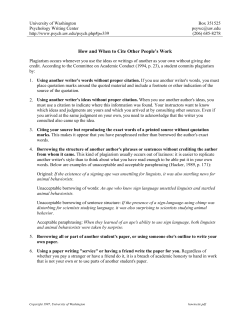
WHY WE CITE SOURCES IN ACADEMIC PAPERS A WRITING CENTRE HANDOUT
WHY WE CITE SOURCES IN ACADEMIC PAPERS A WRITING CENTRE HANDOUT Plagiarism is academic misconduct. Plagiarism might involve: using another person’s writing as your own misrepresenting your research (excluding used sources or including unused sources (“padding”) in your bibliography) paraphrasing too closely misrepresenting an author’s argument In the worst case scenario, plagiarism can get you expelled from university. While some students do plagiarize intentionally, the majority of students do it unintentionally. You can’t assume that you know the rules. Writing with integrity requires knowledge of the specific techniques of inquiry and writing conventions in each academic field of research. It is your responsibility to learn these ways of researching and writing so that you can ensure that you write with integrity. Citation practices aren’t just for students; nor are they just about stealing. They’re concerned with the responsible building of knowledge within research communities. Academic writing is conversation. Academic papers engage with previously established ideas. They respond to these ideas and anticipate further responses to sustain an ongoing dialogue, which is the basis for all academic discourse: "Every time we consult a source, we join and by joining, sustain a conversation that may be decades, even centuries old" (Booth, Colomb and Williams 12). Strong academic arguments rely on citation in order to demonstrate the gap in research that they’re filling, clarify their context and relevance, marshal support and gain authority, & ensure their integrity (soundness, veracity). © Emmy Misser & Stephanie Bell, Writing Centre, Wilfrid Laurier University Website: http://www.wlu.ca/writing Why We Cite: 3 Reasons 1. We cite in order to distinguish between citation and interpretation. How can you demonstrate which ideas and insights are yours if the reader can’t tell where your citations end and your interpretation of them begins? In university papers, you have to demonstrate higher-order thinking skills by “identifying, locating, assessing, and assimilating others’ research and then developing and expressing your own ideas clearly and persuasively” (Gibaldi 2). Demonstrate your ability to engage with others’ arguments by acknowledging ownership of ideas through citation. 2. We cite in order to show how knowledge is formed. Citation shows where you got your understanding of a given topic and whose ideas you’re building upon – it demonstrates the extent to which your argument is reliable. Being able to trace the development of an author’s ideas from other credible sources supports the foundation for the “organized accumulation of academic knowledge” (Walker, Taylor 10). The development of knowledge depends on the honesty of all writers, yours included. The big picture is about knowledge building: each piece of reported research adds to the collective construction of knowledge. Research serves as the foundation on which new contributions to knowledge are responsibly built. 3. We cite sources in order to demonstrate context and significance. Citation helps you develop an argument that addresses the proverbial “so what?” question. When you explain what has already been thought and said on a topic and position your research as a response to this prior conversation, you help your reader understand the context in which you’re writing and the relevance as well as the significance of your research. Works Cited Booth, Wayne C., Gregory G. Colomb, and Joseph M. Williams. The Craft of Research. Chicago: The University of Chicago Press, 1995. Gibaldi, Joseph. MLA Handbook for Writers of Research Papers, 5th ed. New York: The Modern Language Association of America, 1999. Walker, Janice R. and Todd Taylor. The Columbia Guide to Online Style. New York: Columbia University Press, 1998. © Emmy Misser & Stephanie Bell, Writing Centre, Wilfrid Laurier University Website: http://www.wlu.ca/writing Find out WHAT you need to cite and HOW in the next handout
© Copyright 2025





















